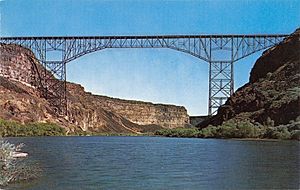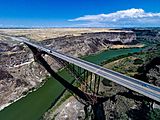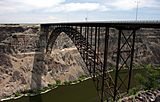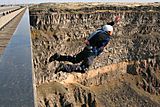Perrine Bridge facts for kids
Quick facts for kids Perrine Bridge |
|
|---|---|
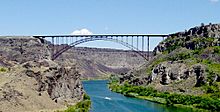
July 2004
|
|
| Coordinates | 42°36′00″N 114°27′13″W / 42.600°N 114.4537°W |
| Carries | 4 lanes of |
| Crosses | Snake River |
| Locale | Twin Falls, Idaho, U.S. |
| Official name | I.B. Perrine Bridge |
| Characteristics | |
| Total length | 1,500 feet (457 m) |
| Width | 64.6 feet (19.7 m) |
| Longest span | 993 feet (303 m) |
| Clearance below | 486 feet (148 m) |
| History | |
| Opened | 1976, 49 years ago 1927 - original (98 years ago) |
The I. B. Perrine Bridge is a famous bridge in the western United States. It is located in Twin Falls, Idaho. This bridge carries U.S. Highway 93 over the amazing Snake River Canyon. It connects Twin Falls to Jerome County and Interstate 84.
The Perrine Bridge is about 1,500 feet (457 meters) long. Its main part stretches 993 feet (303 meters). It stands very high, about 486 feet (148 meters) above the Snake River. This makes it one of the highest bridges in the United States. The bridge deck is about 3,600 feet (1,097 meters) above sea level.
The bridge is named after I. B. Perrine (1861–1943). He led many irrigation projects in the Magic Valley area in the early 1900s. Many people credit him as the main founder of Twin Falls. You can find a statue of Perrine at the visitors' center near the bridge.
History of the Perrine Bridge
The first bridge here was a steel cantilever bridge. It was originally called the Twin Falls-Jerome Intercounty Bridge. This bridge opened in September 1927. It was formally dedicated by Governor H. C. Baldridge on October 1, 1927.
This first bridge cost $750,000 to build. It was paid for by private money. It was also a toll bridge, meaning people had to pay to cross it. In April 1940, the state of Idaho bought the bridge for $482,000. After that, the tolls were removed.
By the early 1970s, the original bridge was old. It could not handle heavy loads anymore. So, it needed to be replaced. Construction on the current bridge began in May 1973. It was finished in July 1976. The new bridge cost $10.56 million. It was dedicated on July 31, 1976. The old cantilever bridge was later taken apart.
Visiting the Perrine Bridge
At the southwest end of the Perrine Bridge, you will find the Twin Falls Visitor Center. This center has souvenirs and gifts. It also offers Idaho products and information for visitors. You can see interactive exhibits about fun activities and history in the area.
The visitor center has great views of the canyon and the bridge. You can also access the trail system along the canyon rim from here. These trails go under the bridge on both sides. This gives you amazing views of the bridge and its structure.
To the east, along the south rim of the canyon, you can see a dirt ramp. This ramp was used by Evel Knievel in September 1974. He tried to jump the Snake River Canyon on his Skycycle X-2. However, his jump was not successful because of a parachute problem. The ramp where he made the leap is on private property. It is about 1.6 miles (2.6 kilometers) east of the bridge. You can see it from the bridge and from different spots along the Canyon Trail. There is a memorial to Knievel near the bridge. It was put there in September 1985. Knievel himself attended the small ceremony.
BASE Jumping at the Bridge
The Perrine Bridge is a very popular place for BASE jumping. People from all over the world come here. It might be the only man-made structure in the United States where BASE jumping is allowed all year. You do not need a special permit to jump here. Jumpers often use the nearby visitor center as a meeting point before and after they parachute from the bridge.
The first recorded jumps from the bridge happened in 1987. Three people from Twin Falls, who were former U.S. Army paratroopers, jumped using military parachutes. They did a test drop first with a large drum. Many successful jumps were made without any problems. In the early 1990s, bungee jumping and parachuting from the bridge became more popular. At first, it was against the law. But by the end of the 1990s, BASE jumping became legal. In July 2006, Dan Schilling jumped off the bridge 201 times in 21 hours. He did this to raise money for charity. A crane lifted Schilling back to the top of the bridge after each jump.


